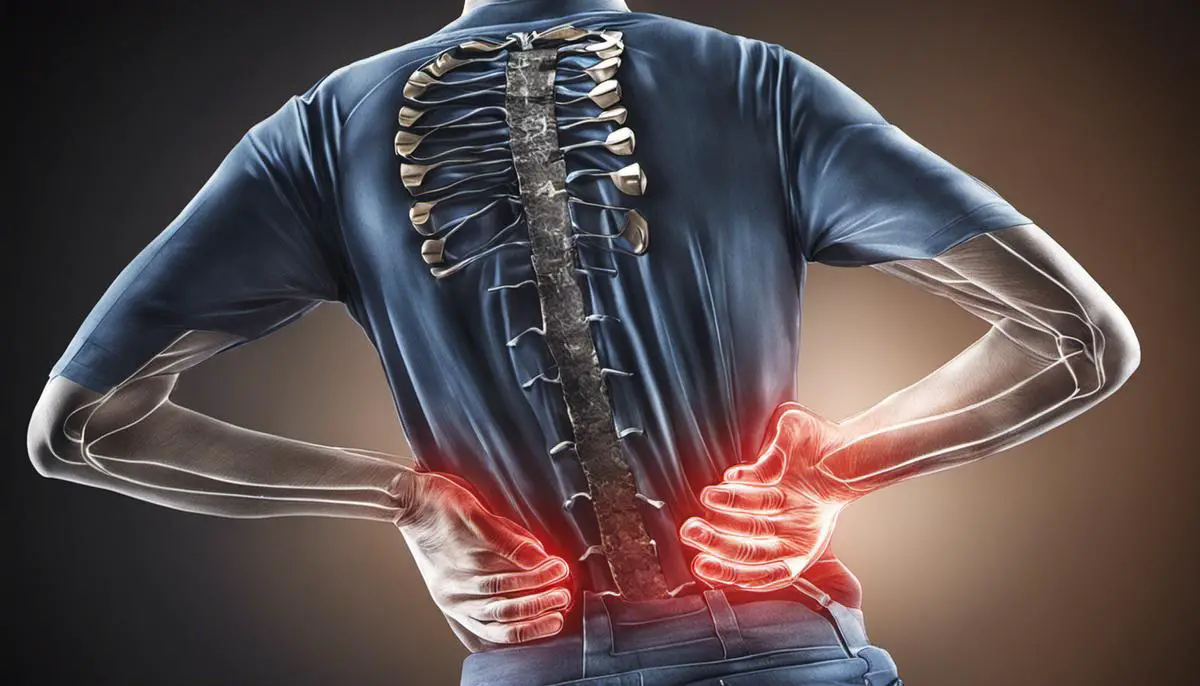The plight of lower back pain – a common, unwelcome guest that hinders daily life, affects mental well-being, and sometimes even impedes mobility. But fear not, understanding is the first step towards the path of relief. Key knowledge on the causes and symptoms of lower back pain, as well as recognizing when it’s the right time to exercise or rest, will arm you in the battle against this ubiquitous ailment. Equally important is education about effective exercises aimed at strengthening the lower back and core, along with understanding the correct form and techniques to prevent further injuries. This paper will guide you through the journey to recovery, presenting a structured approach to integrating these exercises into a regular routine while underlining the crucial roles of consistent effort and gradual progression.
Understanding Lower Back Pain
Understanding Lower Back Pain: Recognizing Common Causes and Symptoms
Lower back pain is a common issue many people face, often due to a variety of factors. Lifting heavy objects without utilizing safe tactics, prolonged periods of sitting with poor posture, and specific health conditions, such as degenerative disc disease and osteoarthritis, can all contribute to discomfort. Additionally, non-physical factors like stress and anxiety can exacerbate the pain. Common symptoms include localized pain in the lower back, radiating pain to the buttock or leg, muscle stiffness or tension in the back, and difficulty with movement that can be severe enough to interfere with daily activities.
Role of Exercise in Alleviating Lower Back Pain
In many cases, exercise can be a helpful tool in managing lower back pain. Activities that improve flexibility and strength, particularly in the core and back muscles, can reduce the strain on the lower back, improve posture, and prevent pain. This could involve exercises such as swimming, yoga, pilates, or cycling. However, the effective implementation of these exercises requires understanding when it is safe to exercise and when it is better to rest or seek medical attention.
Determining When to Exercise
Engaging in gentle movement can help keep the muscles and joints limber, even when you’re experiencing minor lower back pain. Start with light activities such as walking or stretching and gradually increase the intensity as tolerated. The key is to listen to your body. If movement causes severe pain or exacerbates your symptoms, it’s time to rest. Understanding what your body is communicating will help prevent further injuries.
Recognizing When to Rest or Seek Medical Attention
If lower back pain lasts for more than a week, does not improve after rest, extends down one or both legs, causes weakness, numbness or tingling, or is accompanied by unexplained weight loss, it’s important to seek immediate medical attention. If your pain results in sleep disturbances or affects daily activities, it is wise to consult with a healthcare professional. In some cases, resting and allowing inflammation to subside can be beneficial; however, prolonged inactivity can actually worsen low back pain. It is therefore important to find a balance that includes gentle movement alongside periods of rest.
Tailoring the Approach to Individual Needs
Individual response to exercise may differ, it’s crucial to find what works best for you. A wide range of exercise programs are available that can be tailored to meet individual needs, goals, and preferences, from structured physical therapy to home exercise routines. Always consult with a healthcare provider or physical therapist before beginning a new exercise routine, especially if you have a history of back ailments or other medical conditions.

Effective Lower Back Exercises
Stretching for Lower Back Pain Relief
Stretching is a simple and effective activity to help alleviate lower back pain. One recommended stretch is the knee-to-chest stretch. First, lie flat on your back on a comfortable surface, such as a yoga mat. Bend your knees, keeping your feet flat on the floor. Then, bring one knee up to your chest, hold it there with your hands, and hold the stretch for up to 30 seconds. Repeat this stretch multiple times on both legs.
Yoga Poses for Strengthening the Lower Back
Yoga provides numerous poses that can strengthen your lower back and core effectively. One such pose is the Cat-Camel pose. Start by getting on all fours, making sure your hands are directly below your shoulders and knees below your hips. Slowly arch your back upwards, tucking your belly in, resembling a cat’s pose. Hold the position for a few seconds, then relax the spine, letting your belly sink towards the floor, resembling a camel’s pose. Repeat this cycle several times.
Pilates Workouts for Lower Back Muscles
Pilates also offers excellent workouts for lower back pain. The pilates bridge pose is one such exercise. Lie flat on your back with your knees bent and your feet flat on the ground. Keeping your body in a straight line, raise your hips off the floor, so your body forms a straight line from your shoulders to your knees. Hold this pose for a few seconds, then slowly lower your body back down to the floor. Repeat this exercise several times.
Low-Impact Aerobic Exercise
Low-impact aerobic exercise can also be very beneficial for those with lower back pain. Swimming is a particularly effective type of low-impact aerobic exercise because it does not exert pressure on your joints, allowing you to strengthen your back and core muscles without straining your back. Choose strokes that feel comfortable and do not twist your body excessively. Avoid any movements that cause pain.
Prioritizing Correct Form and Technique
When performing these exercises, prioritize maintaining the correct form and technique over the number of repetitions or the intensity of the workout. Improper form might lead to injury or furthering existing issues. If you are just starting these exercises, consider hiring a personal trainer or attending a group class led by a professional. These options can provide feedback on your form and technique, ensuring you’re exercising safely and effectively.
Regularity and Consistency
Consistency is key in any exercise routine. Regularly performing these lower back and core strengthening exercises can contribute significantly to alleviating and preventing lower back pain. This does not mandate daily intensive workouts; even light exercises done consistently can have a positive impact on lower back health.
Consult with Healthcare Professionals
However, always consult with a healthcare professional before beginning any new exercise regimen, especially if you suffer from chronic back pain or any other health conditions. These professionals can give you personalized advice and guidance based on your specific health needs and conditions.

Implementing a Consistent Exercise Routine
Understanding Your Lower Back Pain
To start, it’s essential to understand where your lower back pain might be coming from. Lower back pain can often be the result of stress, poor posture, or inadequate physical conditioning. Chronic pain can usually be attributed to conditions such as degenerative disc disease, herniated discs, or spinal stenosis. Any consistent routine for managing back pain should start with a doctor or physical therapist’s guidance to ensure safety and effectiveness.
Setting Up A Routine
As with any fitness regimen, consistency is key in managing lower back pain. Try to spread your exercises throughout the week, aiming for about 20-30 minutes each day. Choose times of the day when your pain is typically lowest. Mornings may be optimal for most people since your body will have had time to rest and recover during the night.
Choosing Exercises That Support Back Health
Not all exercises are created equal when it comes to managing lower back pain. Some focus on strengthening the core, which safeguards your back by improving balance and stability. Others stretch tight muscles that can exacerbate back pain, like your hips and hamstrings. Here are a few exercises that could help:
- Partial Crunches: Lie back, bend your knees with your feet flat on the floor and cross your hands over your chest. Engage your stomach muscles and lift your shoulders off the floor while keeping your neck relaxed. Repeat 12 times.
- Hamstring Stretches: Lay on your back and raise one leg upwards. Hold the back of your leg and gently pull it towards your chest. Hold the position for 15-30 seconds, then repeat with your other leg.
- Wall Sits: Stand with your back against a wall, then slide down into a sitting position, keeping your back in contact with the wall. Hold for 10 seconds, then slide back up. Repeat 8-12 times.
- Bird Dog: Start on hands and knees. Tighten stomach muscles, then lift and extend one leg behind you while keeping your hips level. Hold for 5 seconds, and then switch to the other leg. Repeat 8-12 times.
Gradual Progression is Key
With lower back pain, jumping into high-intensity exercises can lead to further injuries. Therefore, start with low-intensity, low-impact exercises and gradually increase the intensity and duration as your back becomes stronger. This is why key exercises like partial crunches, hamstring stretches, wall sits, and bird dog are important, as they can be easily modified for beginners and then set to more challenging versions over time.
Know Your Limits
Always remember to listen to your body. While mild discomfort or muscle soreness after a new exercise is normal, sharp or severe pain is not. If a particular exercise causes you pain, stop immediately and consult with a healthcare provider.
The Importance of Consistency
Keeping a regular exercise regimen can help improve flexibility, strength, and endurance. It’s vital to the treatment and prevention of recurring back pain. By consistently making time to exercise and slowly improving your physical capabilities, you can effectively manage your lower back pain.

Proper Rest and Recovery
Understanding the Importance of Rest and Recovery for Lower Back Pain
Rest and recovery are two fundamental aspects of managing lower back pain. Resting is critical because it allows your muscles, ligaments, and spine to heal and reduces the strain and stress on your lower back. During rest, your body works to repair any damage to your muscles and other soft tissues. This helps to speed up recovery and reduce the intensity and frequency of lower back pain.
However, remember that rest does not mean complete immobility. Continued movement helps keep your muscles strong, which supports your lower back. Thus, a balanced approach to rest and light physical activity like stretching and walking can help manage lower back pain effectively.
Role of Heat or Cold Therapy in Pain Management
Heat or cold therapy can also aid in the recovery process. Heat therapy, such as a warm bath or a heating pad, can help to relax and loosen tight muscles relieving physical discomfort. It promotes circulation, carrying oxygen and nutrients to your muscles to accelerate healing.
On the other hand, cold therapy, such as an ice pack or cool cloth, can numb the pain and reduce inflammation by constricting blood vessels and slowing blood flow to the area. It’s best to use cold therapy immediately after the injury or onset of pain, and heat therapy for chronic pain. Always ensure to wrap heating or cooling implements in a towel before applying them directly to the skin to avoid burns or frostbite.
Over-the-counter Pain Relievers: Another Mode of Relief
Over-the-counter (OTC) pain relievers can also contribute to relief and recovery. Nonsteroidal anti-inflammatory drugs (NSAIDs), like ibuprofen, can relieve back pain and inflammation, whereas acetaminophen can assist with general back pain. Remember, these should not be used as a primary treatment, but as a supplement to other recovery efforts. Always ensure that you follow the pharmaceutic guidelines for dosage to avoid potential side effects.
Alternative Therapies: Acupuncture for Lower Back Pain
In addition to traditional methods, alternative therapies like acupuncture can help in managing lower back pain. Acupuncture involves the insertion of thin needles into specific points in your body, aiming to reduce pain and inflammation, as well as promote healing. Although acupuncture’s effectiveness varies among individuals, some research has found it can be beneficial in alleviating chronic lower back pain.
Remember each individual’s experience with lower back pain is unique and should be addressed on a personalized basis. Always consult a healthcare professional or physical therapist for advice if you’re struggling with lower back pain or are unsure about how to manage your pain effectively.

Achieving a life free of persistent lower back pain is not merely a function of effective exercise but involves holistic wellness strategies, including adequate rest, recovery practices, and sometimes, alternative therapy options. The role of proper recovery time and methods such as heat or cold therapy, over-the-counter pain relievers, and alternative therapies like acupuncture should not be overlooked. While the journey to recovery may seem arduous, the profound impact it can have on quality of life is undoubtedly worth the effort. Therefore, let this be an empowering exploration as you uncover a new hope for relief from lower back pain, and let that hope lead the way to a healthier, happier you.
